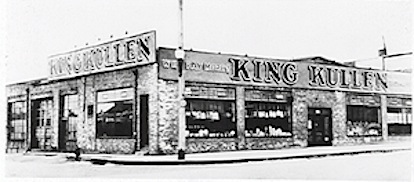I confess that I have a warm spot in my heart for customer service operations. It is probably because I met my wife of 29.5 years Eileen Marie when she and I were on the customer service phones at the Polaroid Corporation. As an old phone jockey, it is apparent to me that the world of customer service is transforming. If we look back in history we can see that the central tendency of consumer businesses is to move more and more function to the end consumer and to provide them more visibility to the availability of the product or service. As the phone grew in this country as a consumer device, clever pundits predicted that in order to meet the emerging demand for phone calls, the entire country would have to become telephone operators, and that is exactly what we are. We dial our own service. Likewise, when the Michael J Cullen opened his first King Kullen store in Jamaica Queens with 6,000 square feet, on August 4, 1930 with the wonderful catch phrase, "Pile it High, Sell it Low", he ushered in the world of super market self service. When they can, firms let customers roll their own.
Today, technology is enabling new capabilities and I see three trends which are recreating customer service in a new, more responsive, and economically efficient manner: transparency, tribes, and talent. The first trend, transparency, is exemplified by Federal Express's efforts over the years. They were among the first companies to "expose" their internal systems so that not only can the customer schedule pick ups, print out labels, and manage their account, but they can also see the same level of detail the firm has on the location of his or her package. Many firms could benefit by letting customers see where their product or service truly is. BMW allows people who have configured and ordered a Mini Cooper to check the status of the order, and see it location on the high seas as it is shipped across the Atlantic. So what? Well, just think about how the dynamic with your cable company would change if you could actually see if the service truck was on its way to your house. It certainly would change the attitude between the customer and the company. Heck, the government enables you to track tagged polar bears!
Seth Godin's book on Tribes talks about groups of people who are passionate about a topic; -- and those firms that are great at harnessing tribes change the nature of customer service. When someone interacts with Dell, they are dealing with the tribe who cares about the product and services of Dell. There are tribes ready to be released about any product or service. There is a tribe who cares about airline travel; there's one that feels passionately about the Porsche, even the world of flat screen TVs has lovers! Those companies who have bad customer service are attacked by the tribe. Those who are good at involve the tribe in creating solutions for other customers. As Seth points out, they need to be lead.

Turning to the third point, I believe unlocking talent is critical to the customer experience. (Godin talks about some of these issues under the term "tribe" but I wanted to separate talent out from tribe.) Let's face it, most of the content that companies put out about how to use their product or service is often terminally boring, or disconnected to the real audience. Lauren Luke is a worldwide make up star. Who is Lauren Luke you ask? She has over 300,000 subscribers, for her YouTube video tutorials on makeup. She has a personality and approach which sings on the small screen, and the YouTube format. The formal star making machinery of any cosmetics company would never even find this woman because she is not famous, gorgeous, nor does she fit the cosmetic model, or spokesperson stereotype. But, she is one of the most well known make up artists in the world. Likewise there are people who are willing to create content which is more engaging and useful. There is no reason that my local cable company could not have a contest for the best user generated content on how to set up a new cable box and program the remote. Some would be fun, others clinical, and with the right contest-like structure the end users will create something so much more engaging than any internal communications group could generate.
The general message is very clear -- open up; involve your audience in crafting solutions as well as the information about your firm's offers to other customers. The economics of this type of customer care are superior to anything that can be done with internal resources alone. When I did an analysis of a customer service organization at IBM many years ago, the codification of solutions into a knowledge base shifted first call resolution from less than 60% to over 90%. Customers were happier. The technical staff could spend their time on new products instead of chasing down customer problems. What's not to like?
The future will be more connected, with more ability for people to share their impressions, stories and advice. In an ever more crowded information market, the natural tendency will be for those people who lead the tribes to become important influencers. Those who generate great new content will be the market movers. Isn't it time to get involved in this emerging customer service structure now -- while there is still time to build a reputation based on "earned media"?
So my questions for you are:
* Are you transparent?
* Do you lead your tribe?
* Have you unlocked the talent latent in your customer base?
Last, and not least, what do you have to lose but the illusion that you are in control of your customers?
